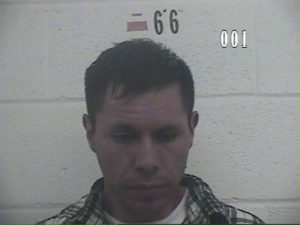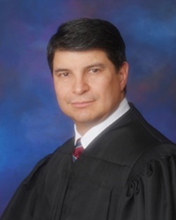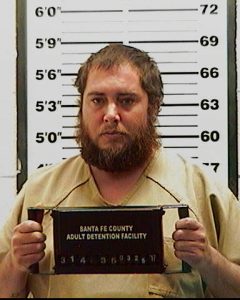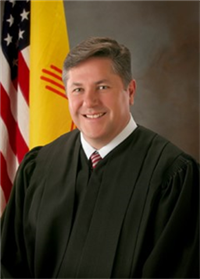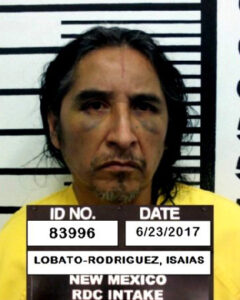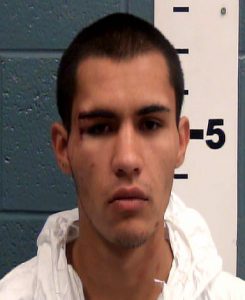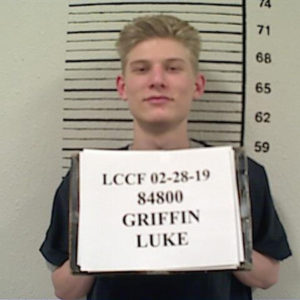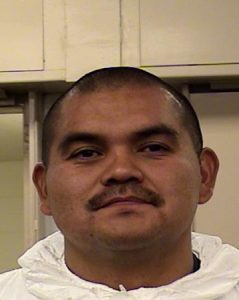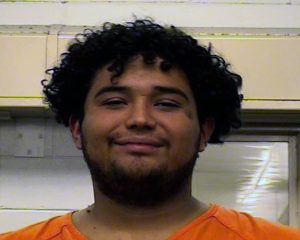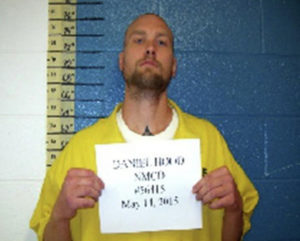- Suspect: Andrew Poteet Magill, 25
- Victim: Mary Ann Moorhouse, 61
- Non-fatal victim: Jason Green
- Charges: First-degree murder
- Status: Plea to second-degree murder, two counts of assault with intent to commit a violent felony on an officer and felon in possession of a firearm
- Sentence: 45 years followed by 5 years supervised probation
- Date of incident: April 1, 2017
- Agency: Lincoln County Sheriff’s Office, State Police, Ruidoso Downs Police Department
- Sentencing judge: Daniel Bryant
- Location: 27544 US Highway 70, Glencoe
- Magistrate case number: M-30-FR-2017-00024
- District case number: D-1226-CR-2017-00064
Summary
On April 1, 2017, Andrew Magill, 25, allegedly drove to the Coe Ranch, near Glencoe on U.S. Highway 70, and confronted Mary Ann Moorhouse, 61, who was helping take care of the property and Magill allegedly chopped her head off with an ax, according to an affidavit for an arrest warrant.
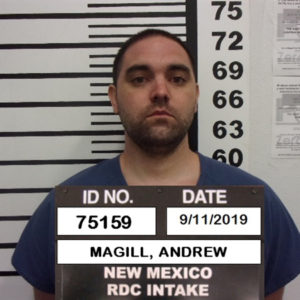
He then allegedly got a ride to the Ruidoso Downs Police Department, 10 miles down the road, from a passing motorist. There, he allegedly told officers he chopped a woman’s head off, he was Jesus, and his father was God, according to the affidavit.
He was then taken to the Lincoln County Medical Center where he got into a struggle with two deputies. Deputy Jason Green dropped his gun and Magill allegedly picked it up and shot him in the arm with it, according to court documents.
He was indicted on a single count of first-degree murder on April 10, 2017.
After being found competent to stand trial, he pleaded not guilty by reason of insanity, on Nov. 15, 2017.
On May 23, 2019, he pleaded guilty to charges of second-degree murder, two counts of assault with intent to commit a violent felony on an officer and felon in possession of a firearm. According to the plea, he agreed that the basic sentences for each count would be increased by 1/3 for aggravating circumstances.
District Court Judge Daniel Bryant sentenced Magill to 45 years followed by five years of supervised probation. He faced a maximum sentence of 51 years.
The two incidents
Danny Sanchez called the Lincoln County Sheriff’s Office at 9:09 p.m., April 1, 2017, to ask that they check on his co-worker, helping him take care of the Coe Ranch on U.S. Highway 70 near Glencoe, Deputy Matt Christian wrote in an affidavit for an arrest warrant for Andrew Magill, 25.
Sanchez told dispatchers that he was out of town and he received a call from Mary Ann Moorhouse, 61, who said someone was on the property and he was going to investigate. He tried to call her several times thereafter, but was not able to get through.
“Lincoln County Deputies Anthony Manfredi and Charlie Evans responded to the Coe Ranch, to welfare check Ms. Moorhouse,” Christian wrote.
They found a white woman lying on the ground in front of one of the residences on the 260 acre property.
“The female had no signs of life, and her head had been almost completely severed,” Christian wrote. “An axe covered in blood was also observed on the ground near the body. Deputies also observed a cell phone on the ground near the body. Deputies Manfredi and Evans then backed away from the residence, and secured the scene.”
Resident Tim Huseman spoke to Christian and told him that he was in Lubbock, Texas, that Moorhouse should be the only person on the property and she did not know he was gone.
“Mr. Huseman said he feared Ms. Moorhouse may have gone to his residence while investigating the suspected intruder, assuming that Mr. Huseman was home,” Christian wrote.
After deputies secured the scene and started to apply for a search warrant, Christian learned that the suspect may have been at the Lincoln County Medical Center.
He had previously been dropped off at the Ruidoso Downs Police Department by a motorist who found him walking on U.S. Highway 70, 10 miles east of Ruidoso, near the ranch.
“It was later learned that Magill’s father had located Magill’s vehicle abandoned near the property and had driven it to the hospital,” Christian wrote.
Christian did not write what the alleged weapon used to kill Moorhouse was, nor did he write how it is thought she died, nor what she was decapitated with.
“Magill was very agitated and appeared to have dried blood on his hands,” Christian wrote. “Magill also had a laceration to his forehead.”
At the police department, Officers Carroll Scott and Charles Williams began talking to him, and then escorted him inside.
“Magill began ranting about being ‘Jesus’ and telling officers that his dad is ‘God,’ and he fought with ‘Satan,'” Christian wrote. “Magill said he had to ‘Kill a man’ and ‘chop a woman’s head off’ with an axe.'”
Because Magill was so agitated, officers called for an ambulance.
While at the hospital, Magill allegedly began to struggle with the deputies there to guard him.
“During the struggle, Deputy Jason Green’ s firearm fell to the ground and Magill retrieved the firearm and shot Deputy Green,” Christian wrote.
The officer was shot in the arm.
[pdf-embedder url=”https://nmhomicide.com/wp-content/uploads/2017/04/PC-Andrew-Magill-4-1-2017.pdf” title=”PC – Andrew Magill – 4-1-2017″]
Indictment
A Lincoln County grand jury indicted Andrew Magill on April 10, 2017, on a single count of first-degree murder for the death of Mary Ann Moorhouse.
Deputy Matt Christian was the only person to testify to the grand jury.
On that same day, District Attorney John Sugg filed a motion of intent to seek an alteration of the basic sentence for aggravating circumstances, which could increase the basic sentence by a third.
According to the Ruidoso News, Magill was found competent to stand trial on Nov. 15, 2017. He was arraigned that day and entered a plea of not guilty by reason of insanity.
On Sept. 12, 2018, Sugg filed an amended grand jury indictment charging Magill with:
- First-degree murder
- Two counts of assault with intent to commit a violent felony on an officer or, in the alternative, aggravated battery on a peace officer
- Felon in possession of a firearm
Plea and sentence
On May 22, 2019, Magill pleaded guilty to second-degree murder, two counts of assault with intent to commit a violent felony on an officer and felon in possession of a firearm. District Court Judge Daniel Bryant accepted the plea.
As a part of the plea, he admitted he was convicted of drug trafficking on May 3, 2010, in case number D-504-CR-2009-00501, from a case in Chaves County.
The plea agreement states that Magill agreed that the basic sentence for each count would be increased by 1/3 for aggravating circumstances, but it also states there were no agreements as to sentencing and that the court was not bound to “those recommendations,” although it is not clear what recommendations the document is referring to.
The plea agreement also states the sentence for second-degree murder would be increased from 15 years to 20 years for aggravating circumstances, and an additional year added because of Magill’s prior trafficking conviction.
The two counts of assault with intent to commit a violent felony had their sentences increased from nine to 12 years, and increased by another two years for a firearms enhancement and the prior conviction.
The felon in possession of a firearm charged was increased to two years from 18 months.
The maximum sentence, under the plea, was 51 years.
According to the Ruidoso News, a psychiatrist hired by prosecutors found Magill killed Moorehouse during a “drug-induced psychosis.” Sugg said during a press conference, after the plea hearing, that the psychiatrist was paid $100,000.
Magill believed himself to be Jesus Christ and killed Moorehouse to save the world, Sugg said, according to the Ruidoso News.
In a press release dated May 23, 2019, Sugg wrote a long narrative outlining Magill’s movements and actions, which started on March 30, 2017, when he was staying at the Drury Hotel in Albuquerque with his wife and daughter. He began having hallucinations that he was being attacked by the devil and that he was Jesus Christ.
“Magill got into an altercation with a front desk employee at the hotel after losing his room key, and he threatened the employee before causing thousands of dollars of damage to the hotel,” Sugg wrote. “Magill retreated to his room where he quickly packed his family’s belongings and hurried his wife and daughter down the stairwell before police arrived.”
Magill started driving toward Roswell when he became convinced his luggage was cursed, stopped on the side of the road and threw out his family’s belongings. His hallucinations continued and he became convinced the world was ending and began threatening his wife and daughter. Once his wife had a chance to leave, she did and went to a relative’s house. Magill headed toward Ruidoso from Roswell and stopped at the Coe Ranch, he wrote.
After killing Moorehouse, he baptized himself in a creek and hitchhiked to the Ruidoso Downs Police Department and told them he kiled a man and chopped off a woman’s head with an axe to save the world. Officers transported him to the Lincoln County Medical Center for a mental health evaluation, Sugg wrote.
Stipulation of facts and aggravating circumstances
On May 22, Sugg signed a stipulation of facts that outlined the aggravated circumstances for increasing Magill’s sentence by 1/3. That stipulation of facts outlines the course of events.
The aggravated circumstances were:
- Lack of remorse
- Brutal nature of the crime
- Future dangerousness
- Prior unsuccessful rehabilitative efforts
- Impact on the families of Mary Ann Moorehouse and Jason Green
According to the stipulation of facts, Magill did not express remorse for either killing Moorehouse or shooting Green.
He told Dr. Michael Welner that his greatest regret was not being able to be with his daughter and never expressed remorse for his crimes in hundreds of hours of jail phone calls. When asked about significant painful experiences in his life, he did not mention these crimes as being among them. In his interview with Dr. Noah Kaufman, he could not remember Ms. Moorehouse’ s name and stated, “I was just really scared and desperate to end what I was going through. And I hoped she would have comforted me. But she didn’t. She was kind of standoffish and weird.”
The impact on Moorehouse’s family and on Green were profound. Green suffered “career-ending injuries” because of the attack and Moorehouse’s mother sufferes from short-term memory loss and can’t remember what happened to her daughter, according to the stipulation.
“Each time she forgets what happened to her daughter, her family has to tell her what happened and she has to relive learning about her daughter’s horrific death as if she was hearing it for the first time,” according to the stipulation.
Sentencing
Bryant Magill held sentencing hearings on Sept. 5 and 6, 2019 and, at the end, sentenced Magill to 45 years in prison followed by five years of supervised probation. (He sentenced Magill to 51 years but suspended six years.) If he violates his probation after being released, he could be sentenced to the remaining six years of his sentence.
All the crimes were considered serious violent offenses, meaning Magill must serve 85 percent of his sentence before being eligible for release, or just over 38 years. However, he also received credit for over two years time served while awaiting trial.
According to a press release from Sugg, dated Sept. 6, 2019, Bryant considered Magill’s mental health to be a mitigating factor and wanted him to be supervised for longer after he is released from prison, and that was why he did not impose the maximum sentence.
Bryant wrote he recommended, under the special conditions of probation, that Magill be screened for a “treatment guardian.”

